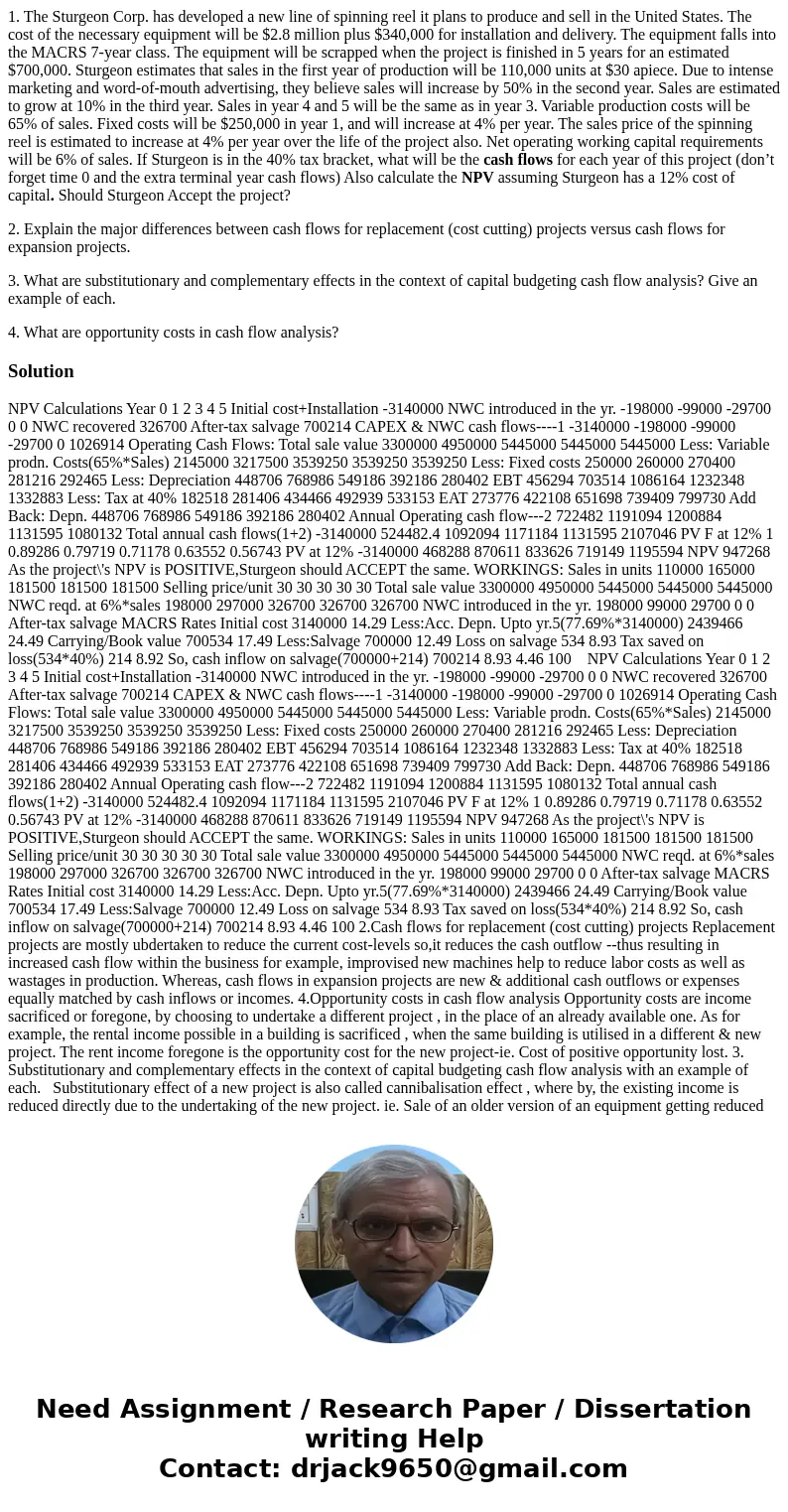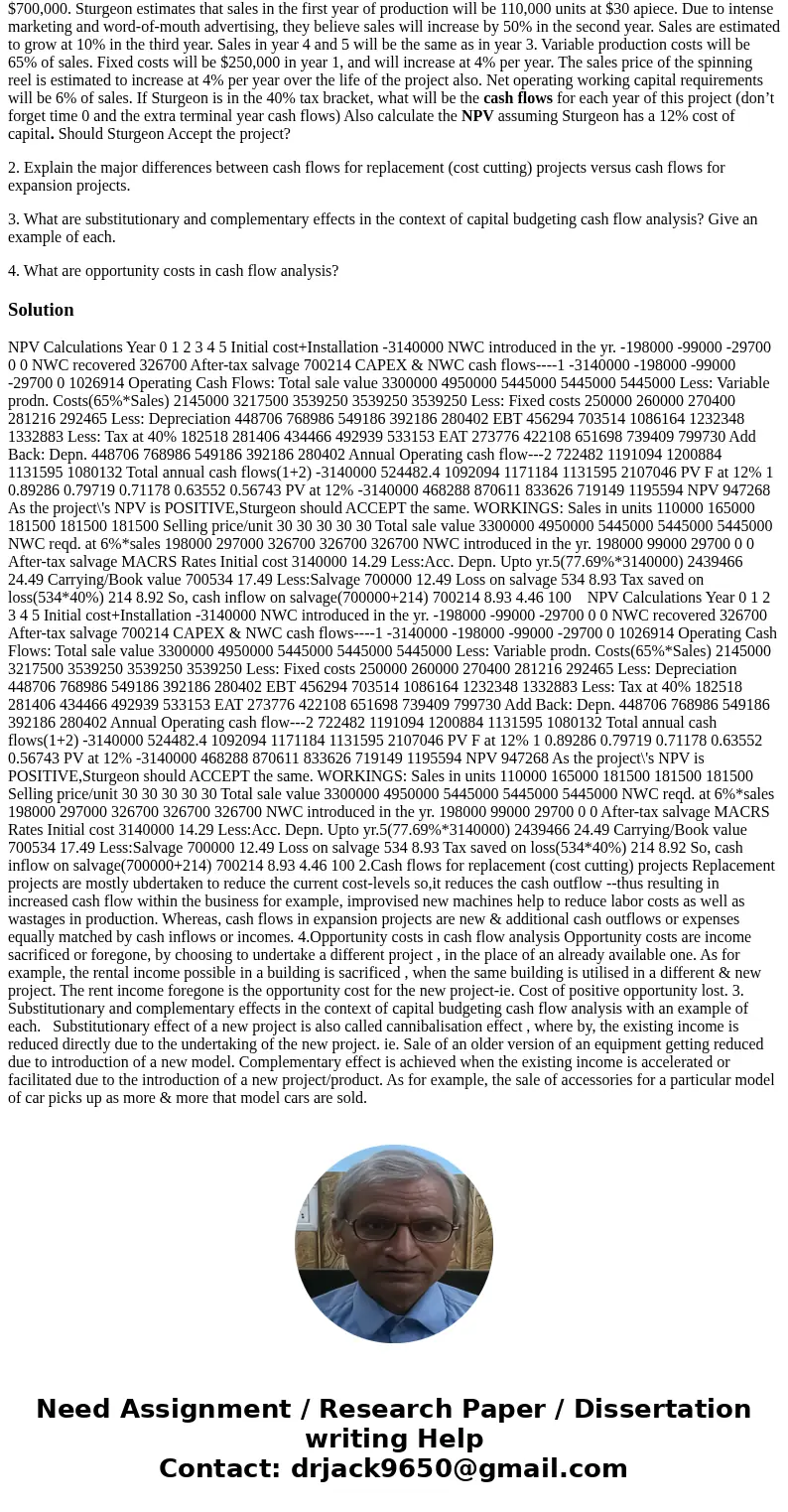1 The Sturgeon Corp has developed a new line of spinning ree
1. The Sturgeon Corp. has developed a new line of spinning reel it plans to produce and sell in the United States. The cost of the necessary equipment will be $2.8 million plus $340,000 for installation and delivery. The equipment falls into the MACRS 7-year class. The equipment will be scrapped when the project is finished in 5 years for an estimated $700,000. Sturgeon estimates that sales in the first year of production will be 110,000 units at $30 apiece. Due to intense marketing and word-of-mouth advertising, they believe sales will increase by 50% in the second year. Sales are estimated to grow at 10% in the third year. Sales in year 4 and 5 will be the same as in year 3. Variable production costs will be 65% of sales. Fixed costs will be $250,000 in year 1, and will increase at 4% per year. The sales price of the spinning reel is estimated to increase at 4% per year over the life of the project also. Net operating working capital requirements will be 6% of sales. If Sturgeon is in the 40% tax bracket, what will be the cash flows for each year of this project (don’t forget time 0 and the extra terminal year cash flows) Also calculate the NPV assuming Sturgeon has a 12% cost of capital. Should Sturgeon Accept the project?
2. Explain the major differences between cash flows for replacement (cost cutting) projects versus cash flows for expansion projects.
3. What are substitutionary and complementary effects in the context of capital budgeting cash flow analysis? Give an example of each.
4. What are opportunity costs in cash flow analysis?
Solution
NPV Calculations Year 0 1 2 3 4 5 Initial cost+Installation -3140000 NWC introduced in the yr. -198000 -99000 -29700 0 0 NWC recovered 326700 After-tax salvage 700214 CAPEX & NWC cash flows----1 -3140000 -198000 -99000 -29700 0 1026914 Operating Cash Flows: Total sale value 3300000 4950000 5445000 5445000 5445000 Less: Variable prodn. Costs(65%*Sales) 2145000 3217500 3539250 3539250 3539250 Less: Fixed costs 250000 260000 270400 281216 292465 Less: Depreciation 448706 768986 549186 392186 280402 EBT 456294 703514 1086164 1232348 1332883 Less: Tax at 40% 182518 281406 434466 492939 533153 EAT 273776 422108 651698 739409 799730 Add Back: Depn. 448706 768986 549186 392186 280402 Annual Operating cash flow---2 722482 1191094 1200884 1131595 1080132 Total annual cash flows(1+2) -3140000 524482.4 1092094 1171184 1131595 2107046 PV F at 12% 1 0.89286 0.79719 0.71178 0.63552 0.56743 PV at 12% -3140000 468288 870611 833626 719149 1195594 NPV 947268 As the project\'s NPV is POSITIVE,Sturgeon should ACCEPT the same. WORKINGS: Sales in units 110000 165000 181500 181500 181500 Selling price/unit 30 30 30 30 30 Total sale value 3300000 4950000 5445000 5445000 5445000 NWC reqd. at 6%*sales 198000 297000 326700 326700 326700 NWC introduced in the yr. 198000 99000 29700 0 0 After-tax salvage MACRS Rates Initial cost 3140000 14.29 Less:Acc. Depn. Upto yr.5(77.69%*3140000) 2439466 24.49 Carrying/Book value 700534 17.49 Less:Salvage 700000 12.49 Loss on salvage 534 8.93 Tax saved on loss(534*40%) 214 8.92 So, cash inflow on salvage(700000+214) 700214 8.93 4.46 100 NPV Calculations Year 0 1 2 3 4 5 Initial cost+Installation -3140000 NWC introduced in the yr. -198000 -99000 -29700 0 0 NWC recovered 326700 After-tax salvage 700214 CAPEX & NWC cash flows----1 -3140000 -198000 -99000 -29700 0 1026914 Operating Cash Flows: Total sale value 3300000 4950000 5445000 5445000 5445000 Less: Variable prodn. Costs(65%*Sales) 2145000 3217500 3539250 3539250 3539250 Less: Fixed costs 250000 260000 270400 281216 292465 Less: Depreciation 448706 768986 549186 392186 280402 EBT 456294 703514 1086164 1232348 1332883 Less: Tax at 40% 182518 281406 434466 492939 533153 EAT 273776 422108 651698 739409 799730 Add Back: Depn. 448706 768986 549186 392186 280402 Annual Operating cash flow---2 722482 1191094 1200884 1131595 1080132 Total annual cash flows(1+2) -3140000 524482.4 1092094 1171184 1131595 2107046 PV F at 12% 1 0.89286 0.79719 0.71178 0.63552 0.56743 PV at 12% -3140000 468288 870611 833626 719149 1195594 NPV 947268 As the project\'s NPV is POSITIVE,Sturgeon should ACCEPT the same. WORKINGS: Sales in units 110000 165000 181500 181500 181500 Selling price/unit 30 30 30 30 30 Total sale value 3300000 4950000 5445000 5445000 5445000 NWC reqd. at 6%*sales 198000 297000 326700 326700 326700 NWC introduced in the yr. 198000 99000 29700 0 0 After-tax salvage MACRS Rates Initial cost 3140000 14.29 Less:Acc. Depn. Upto yr.5(77.69%*3140000) 2439466 24.49 Carrying/Book value 700534 17.49 Less:Salvage 700000 12.49 Loss on salvage 534 8.93 Tax saved on loss(534*40%) 214 8.92 So, cash inflow on salvage(700000+214) 700214 8.93 4.46 100 2.Cash flows for replacement (cost cutting) projects Replacement projects are mostly ubdertaken to reduce the current cost-levels so,it reduces the cash outflow --thus resulting in increased cash flow within the business for example, improvised new machines help to reduce labor costs as well as wastages in production. Whereas, cash flows in expansion projects are new & additional cash outflows or expenses equally matched by cash inflows or incomes. 4.Opportunity costs in cash flow analysis Opportunity costs are income sacrificed or foregone, by choosing to undertake a different project , in the place of an already available one. As for example, the rental income possible in a building is sacrificed , when the same building is utilised in a different & new project. The rent income foregone is the opportunity cost for the new project-ie. Cost of positive opportunity lost. 3. Substitutionary and complementary effects in the context of capital budgeting cash flow analysis with an example of each. Substitutionary effect of a new project is also called cannibalisation effect , where by, the existing income is reduced directly due to the undertaking of the new project. ie. Sale of an older version of an equipment getting reduced due to introduction of a new model. Complementary effect is achieved when the existing income is accelerated or facilitated due to the introduction of a new project/product. As for example, the sale of accessories for a particular model of car picks up as more & more that model cars are sold.

 Homework Sourse
Homework Sourse